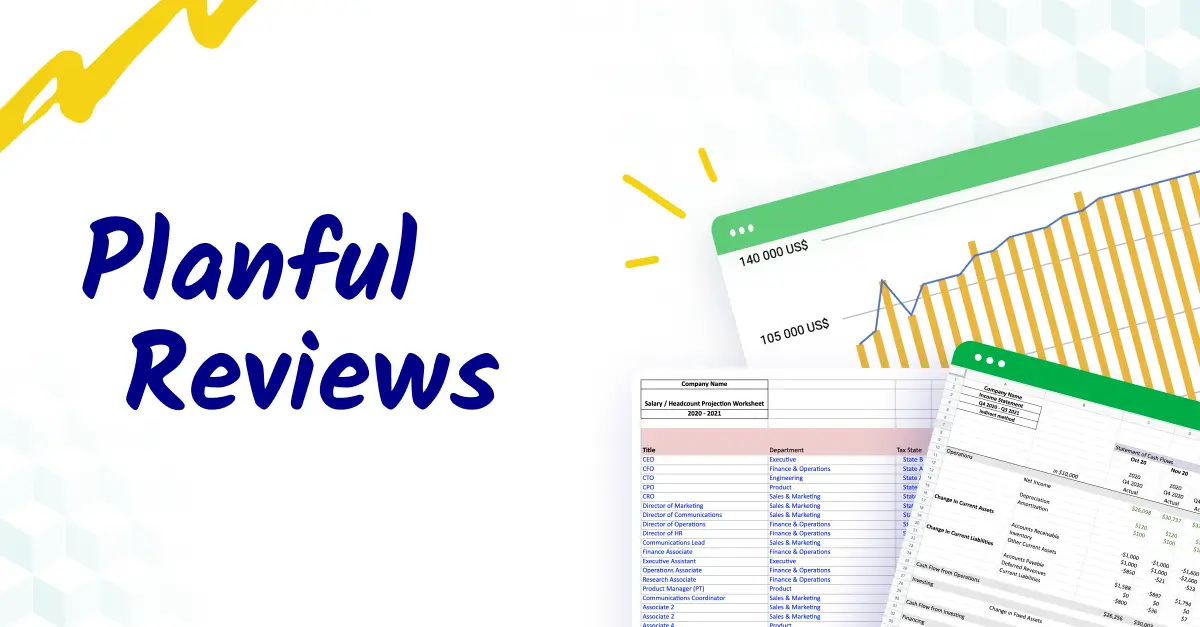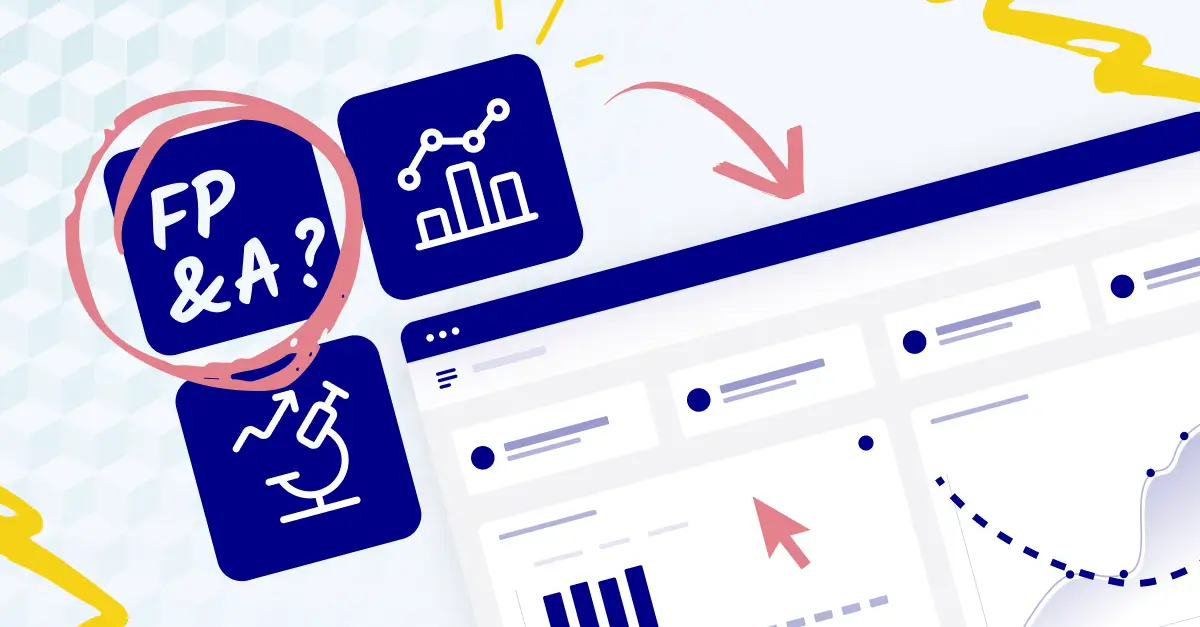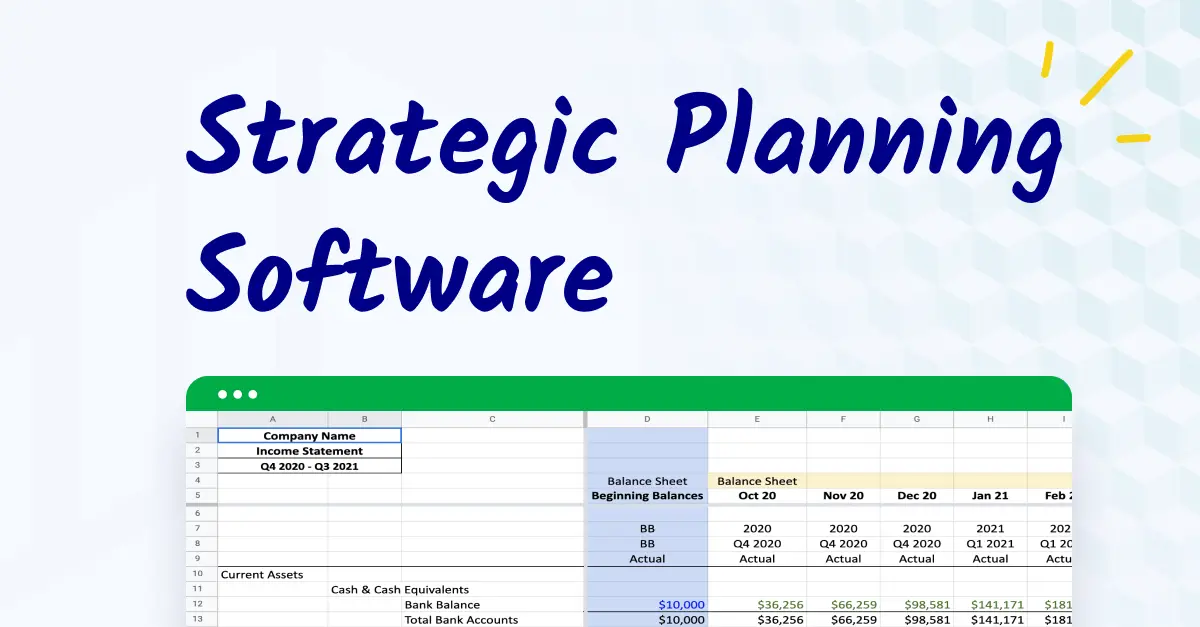Contents
- What is Planful?
- What does Planful do?
- Planful pros
- Planful cons
- Planful use cases
- Planful alternatives
- Conclusion: is Planful for me?
What is Planful?
Planful, formerly Host Analytics, is a cloud-based financial performance management tool for financial planning and analysis (FP&A) teams.
It helps those teams plan, close, and report in a more efficient manner. Like most modern FP&A software, it helps teams make more confident decisions and reduce reliance on manual processes.
While Planful offers a wide range of features, its limitations might make it not the best choice for fast-growing companies with evolving financial consolidation and management reporting needs.
Planful's biggest competitors are other top-tier FP&A tools like Cube, Anaplan, Workday Adaptive Planning, and Vena Solutions.
What are the key Planful features?
Planful helps FP&A teams save time and automate manual processes.
Its key features include:
and so on.
So Planful is definitely a tool with a LOT of use cases.
Who is Planful for?
The majority of Planful's users are mid-market companies, according to Rowan Tonkin, CMO at Planful.
While Planful does have larger businesses in its customer base, the majority of Planful users are comfortably mid-market.
So small businesses might not need all the features and Planful might not be powerful enough for very large enterprises.
How do you implement Planful?
Planful promises a finance-owned platform with “minimal IT involvement.” However, the platform is reportedly hard to integrate and get off the ground. This requires some upfront investment from IT professionals or (in the absence full internal IT team) consulting from outside agencies to implement.
This is due to the myriad of connectors. More complex organizations will have a much longer onboarding period.
Competitive consultants offer an 8-to-12 week Planful implementation plan.
(By contrast, Cube offers fully Excel-native functionality. If you’d like to see how we do it, request a demo of the Cube platform!)
What does Planful do?
Like other FP&A tools, Planful (formerly Host Analytics) offers solutions for managing enterprise-class financial planning.
This means speeding up financial processes by improving how FP&A teams manage financial data.
Does Planful integrate with Microsoft Excel?
Technically no.
Planful promises users an environment where they can handle complex financial processes while working in a familiar, Excel-modeled environment. The platform isn’t Excel-native---you need to use a separate plug-in that converts your Excel data into a Planful template.
That plug-in is called AirliftXL, and it only works with one kind of Planful template. You can only install it on Windows 7 machines and as of this writing, it isn't compatible with SSO users.
So you have to have Planful native on your machine, which is a dealbreaker if you're not running Windows 7.
Planful integrates with AirliftXL, which then integrates with Excel. But Planful and Excel don't directly interact with each other.
Dashboards and Reporting
Planful offers templated, automated, and ad-hoc reporting and analysis capabilities designed to help teams surface insights and distribute those findings to stakeholders.
- The financial and regulatory reporting tools enable presentation-quality reports and allow users to conduct self-service analysis.
- Collaborative investigation tools allow teams to explore variances with the help of AI and machine learning-driven insights, drill-through, pivot, and ad-hoc reporting.
- Distribution features allow users to deliver completed reporting and financials to relevant stakeholders automatically.
Financial close and financial consolidation
Planful lets you aggregate and validate data automatically for conducting month-end closing quickly and with a high degree of confidence.
With Planful's easy-to-create financial reports, your financial close is faster than before.
Financial planning
Planful promises to automate the manual intervention of collecting data in order to reduce risk and save time.
This FP&A cloud software promises to continuously improve your team's financial IQ and bring more insights to the business.
Workforce planning
You can connect your HRIS and ERP to Planful. This means you can collect your workforce data in a single place.
Combine that with Planful's what-if scenario planning abilities and you're well on your way to building a workforce strategy.
Secure financial data
Planful’s most attractive features are its security and intelligence capabilities.
The platform offers multi-layer security to ensure sensitive information remains secure.
Planful features verification features such as role-based security, audit reporting, and easy security setup.
Dynamic planning
Planful contains a dynamic planning engine, which is "an advanced multi-dimensional engine and analysis tool designed to support operational planning and advanced analysis."
Built for the web and Excel front-end, it allows for rapid ad hoc queries and formatted reporting.
Dyamic planning helps make performing what-if analysis using your Planful data much simpler.
Planful Pros
Planful has plenty to offer.
Lots of features
Planful has enough features to offer flexibility for organizations.
With a mix of financial budgeting, forecasting, scenario planning, and wider financial management features, the platform is functionally capable of meeting the needs of mid-market businesses.
Not Excel-based, but not worlds away
While the switch to Planful means giving up Excel, the leap isn't so big...at least when it comes to the syntax.
Excel power users will note the similarities to Planful's syntax.
It should be noted that Planful is not an Excel-native platform.
Tier-based pricing
Although Planful does not make its pricing structure public, reviews often refer to its competitive pricing structure as a plus.
It’s a fully-featured platform that competes in the top 10 with other options mentioned in this review.
However, smaller businesses may find the system has more features than they will use early in the journey, and as businesses scale, the affordable price has potential tradeoffs.
(More on those below.)
Planful Cons
Although Planful provides a solid alternative to more expensive solutions for younger or more budget-conscious companies, there are a few drawbacks to note when evaluating the platform:
Less-than-ideal implementation processes
One of the most common criticisms of Planful concerns the implementation process. In some cases, implementation required the use of third-party consultants to help with migration.
As one reviewer shared, “Integration has gone on for months—multiple re-occurring errors due to the integration team.”
It's worth noting that this is an outlier—most Planful implementations take between 8 to 12 weeks—but those worst-case scenarios can happen, especially when you add third parties like external consultants.
Also: implementing Planful is expensive.
Slow data retrieval and manipulation
Data retrieval and manipulation within the system are slow, and reporting is sometimes over-complicated.
One user reported, “data pull is not immediate and can cause some frustration if data is not pulled 100% accurately the first time.”
Another user expressed concern about the ability to scale with its inherent size limitations.
So while Planful helps teams save time, the exact value of that time is a little suspect.
Steep learning curve means a long time to value
Users describe the learning curve as steep and “non-intuitive,” with a dated UI that makes the system more difficult to navigate.
The platform is reportedly more technical than other solutions and, therefore, not best suited for the layman user.
Compounding the issues with adoption, reviewers report that the training and onboarding materials aren’t sufficient for bringing new users up to speed.
So if your organization needs a great tool with quick time-to-value, you might express some concerns about Planful.
Mixed customer service reviews
The company gets mixed reviews in terms of customer service.
While more recent reviews applaud improvements in the customer services and customer support experience, support services and response times have been an issue in the past.
If that white glove service is important to you, Planful isn't your best option.
Planful Pricing
Planful does not disclose its pricing structure, though reviews describe it as more cost-competitive than other similar platforms like Anaplan or Workday Adaptive Planning.
While no definitive information could be found through 3rd party data sources, Peerspot quotes one user as saying the platform requires multi-year contract pricing.
Planful Use Cases
The Planful platform offers functionality for multiple departments that plan or track corporate spending:
Finance
Financial planning and analysis users use Planful to create budgets and forecasts, build annual operating plans, forecast cash flow, build reports, and conduct scenario analysis.
Accounting
The AP and AR departments use planful for financial close, running financial reports, and consolidating financial data.
HR
Human resources can use the platform to conduct workforce planning, compensation modeling, strategy-building, and capacity planning.
Marketing
Planful is useful for professionals managing the marketing budget, estimating marketing ROI, and planning their marketing spending.
Planful Alternatives
There are more options for FP&A than ever, with companies offering financial analysis solutions at many price points and for different target companies in mind.
Let's look at some Planful alternatives.
1. Cube

Cube is the first spreadsheet-native FP&A platform that empowers teams to drive better planning and performance without changing how they work. Its cloud-based FP&A software platform helps finance teams work anywhere—integrating natively with both Excel and Google Sheets—so that they can plan, analyze, and collaborate with the ultimate speed and confidence.
Many high-growth companies (like Masterworks and Unqork) use Cube for all their FP&A needs.
Because here's the thing:
Cube can do almost everything Planful does, and then some. For example, Cube:
- Has a true, native Excel integration with all versions of Excel (no coding or formulas needed)
- Is always reliable during sophisticated Excel calculations
- Onboards new accounts 5x faster than the competition
- Uses simple formulas for creating reports
- Integrates with almost all source systems
- Works perfectly on Mac OS X and Google Sheets
Perhaps even more importantly, Cube was founded by a former CFO. The problems and use cases of FP&A have been baked into Cube since its inception.
FP&A teams already know and love spreadsheets and Cube simplifies many of the headaches of the often challenging planning process—like collecting actuals from other departments or checking and verifying that your numbers are correct—and lets teams turn their complicated budgeting process into a lean operation.
Check out all of the 5-star reviews on Capterra.
Sounds like a fit? Book your demo with Cube today. Keep scrolling to learn more.
%20(1)%20(1).png?width=600&height=361&name=Big%20image_Howcubeworks_V2%20(4)%20(1)%20(1).png)
Features:
- Automated data consolidation: Connect real-time data from numerous sources for automated rollups and drilldowns.
- Multi-scenario analysis: Allows you to model how changes to key assumptions affect overall outputs seamlessly.
- Endless integrations: Integrations for spreadsheets (Google and Excel), accounting & finance, HR, ATS, billing & operations, sales & marketing, and business intelligence.
- Customizable dashboards: Gives you full ability to build and share customizable dashboards.
- Native Excel and Google Sheets integration: Compatible and bi-directional with any spreadsheet
- Multi-currency support: Evaluate your financials in both your local and reporting currencies.
- User-based controls: User controls, validations, and an audit trail ensure that the right data goes to the right people at the right time.
- Centralized formulas and KPIs: Store all your calculations in a central location and manage from a single source of truth.
- Drilldown and audit trails: Get straight to the transactions and history behind a single cell of data in just one click.
➡️ See all of our features here.
Pros:
- Powerful reporting and KPIs help automate and analyze important data.
- Streamline manual data, reduce errors, and improve collaboration so you can make smarter business decisions in a fraction of the time.
- You can easily collaborate with industry-leading FP&A experts and an award-winning support team.
- Integrations with dozens of applications.
- True, native Excel integration with all versions of Excel (no coding or formulas needed)
- Always reliable during sophisticated Excel calculations
- Standard implementation time that's 5x shorter than the competition
- Quick fresh and fetch times
- Intuitive, easy, and customizable reporting
- Simple formulas for making reports
- User-friendly user interface and controls
- Easy permission management
- Integrates with more source systems
- Has full Mac OS X compatibility
- Is an always-correct single source of truth
- Built and designed by a former serial CFO
Cons:
- Cube works best for mid-sized and commercial businesses—it’s not a personal finance app.
- Cube is built for finance professionals and is not a solution for learning FP&A for the first time
- Pricing (below) is not designed for pre-series A startups
Pricing:
- Starting at $1,250/month for lean finance teams and $2,450/month for companies looking to scale. See detailed pricing.
Best for: Mid-size and enterprise FP&A teams looking to save time and grow. Cube also works for hypergrowth SMBs who want a solution that will scale with their organization's complexity.
Curious to see if Cube is a fit for your company? Book your demo now.
2. Anaplan
.png?width=150&height=33&name=Anaplan_logo%20(1).png)
Anaplan is a web-based planning and forecasting application. It's designed to help organizations make decisions by giving them real-time access to data. The application offers the ability to create and manage models, share data across teams, and collaborate on projects.
Anaplan works to help businesses make decisions by evaluating options and trade-offs in the current environment in real time. Anaplan also offers signal analysis to uncover insights and adapt to continually changing conditions and markets.
Key Features
- Forecasting: Applies audience intelligence, machine learning, and algorithms to your signals
- Scenario modeling: Gauges the impact of changes and adapts your strategy with scenario modeling
- Anaplan Workflow: Digitizes your processes and drives effective conversations
- Anaplan Data Hub: Houses information needed to execute the planning scenarios

Pros
- Web-based application
- Aggregates data into a single source of truth
- Enables real-time collaboration with your team
- Enforce segregation of duties and enable audit tracking within the user interface
- Synchronize structure between models
Cons
- Formula auto-complete functionality similar to Excel
- Sizing can become an issue for new model builders
- There can be some lag in saving data inputs
- The software doesn’t offer the most customization or flexibility.
Pricing
- Pricing is not listed on the website
Best for
Anaplan is a good choice for larger enterprises that have a strong IT team to support implementation.
Check out our full review of Anaplan here.
3. Workday Adaptive Planning

Workday Adaptive Planning allows users to forecast, budget, and model.
In addition to its forecasting capabilities, Adaptive Insights also offers several other features, including the ability to track KPIs, create what-if scenarios, and collaborate with colleagues in real-time.
Adaptive delivers automation across its attract-to-pay process, which eliminates manual tasks and helps your team focus on other goals.
It also models hiring, transfers, and retention plans with driver-based assumptions to help you see the cost impact.
Key Features
- Profitability analysis: It allows you to create various documents from internal reports to external regulatory statements in one system.
- Payroll and workforce management: Visualize workforce costs and trends, identify the root cause, and take action.
- Analytics and reporting: The financial, workforce, and operational data comes together in one place.
- Human capital management: Machine learning provides insights into team member’s skills and improvements needed.

Pros
- It allows you to forecast which resources you need, define roles, and shop for talent in one dashboard
- Plan sales resources, set quotas, and optimize rep capacity
- Flexible budgeting, scenario planning, and reporting options
- Collaboratively run sourcing events, streamline supplier selection, manage contracts, and analyze your performance
Cons
- Setting up Adaptive Insights can be a difficult process
- Some lack of functionality
- Struggles with data integration
- The software can be slow
Pricing
- Workday Adaptive Planning does. not list pricing on its website.
Best for
Adaptive Insights is best for larger enterprises who need workforce, sales, and operational planning support.
4. Vena Solutions

Built for enterprises, Vena Solutions is a financial planning and analysis solution that allows companies to create a centralized solution with automated workflows that are reliable for data analysis and decision-making.
Vena supports companies’ financial systems by lessening the workload for manual labor and optimizing overall operational performance. With specific tasks assigned to each team member, automated processes help reduce bottlenecks and increase efficiency.
Key Features
- What-if modeling, statistical analysis
- Graphical data presentation, modeling, simulation
- Performance metrics, sales trend analysis
- Capital asset planning and cash management
- Consolidation/roll-up
- Run rate tracking
- Version control
Pros
- Data-driven strategic planning
- Visual data storytelling
- Future mobile support
- Training support
Cons
- Reported glitches during set-up and installation
- Relatively high learning curve for users
- Error messages are not specific enough for new users
- Lacks some key features
- Can be expensive for smaller or mid-sized companies
Pricing
- Vena does not provide pricing details on their website.
Conclusion: is Planful for you?
Although Planful fans celebrate the tool’s flexibility, the unique value proposition of “continuous value from day one” may not be applicable in all instances, especially in the face of protracted and error-prone implementation.
The platform’s limitations may not be apparent to all users. Still, speed issues tend to scale along with data complexity, prompting the need for workarounds or technical burdens as company financial needs evolve.
While the difference in price point might make Planful an attractive option, in terms of total cost and long-term potential value, you should consider other options in the market, such as Adaptive Workday, Anaplan, and Cube.







.png)






%20(1)%20(1).png?width=600&height=361&name=Big%20image_Howcubeworks_V2%20(4)%20(1)%20(1).png)





